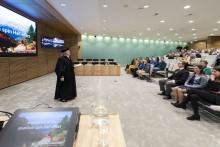Why ask convicted criminals to put on a VR headset and spend an hour in a digital world? The main idea behind Iris van Sintemaartensdijk’s research – and the Virtual Burglary Project – was to understand burglars’ decision making process. In other words, trying to pinpoint how burglars select ‘their targets’ and what could be done to prevent burglaries. And virtual reality offers unprecedented opportunities in this regard.
‘VR is a great tool for this type of research’
‘VR is a great tool for this type of research,’ says Van Sintemaartensdijk from the group Psychology of Conflict, Risk and Safety at the University of Twente. ‘There are other methods and data we can use, such as interviews, but those don’t help us understand the burglars’ decision making process. This has to do with several factors. Firstly, our memory is certainly not perfect, we tend to forget many details as human beings. On top of that, especially in this case, not everyone will be completely truthful during an interview. There might be some secrets that you simply want to keep.’
Setup used for the research
You can avoid all the above using VR, because our minds are not (yet) trained to distinguish between a virtual reality and an actual reality. ‘With VR, you can put people in the desired setting and you can observe their decision making directly - in a nearly real-life environment. You can even see their physical reaction, because people react as if they were physically in the VR environment. Just think of the VR rollercoaster. Intellectually you know that you are sitting in a safe room with VR glasses on your head, but your body doesn’t know and responds as if you were on the ride,’ says the UT scientist. ‘That is why VR offers us a unique peek into the mind of a burglar.’
Guardianship
Van Sintemaartensdijk’s PhD research focused on burglars’ scouting process. More specifically, she investigated the role of guardianship, meaning physical or symbolic presence of other people, on burglars’ behavior. ‘Guardianship is known to be very important in prevention of crime, but there are rarely any studies involving burglars themselves and how they experience guardianship. For example, we wanted to know if street signs, announcing there is a neighborhood watch, help in deterring burglars. Further, I wanted to explore how burglars behave if there is a person on the street, if they are looking at them or even interact with them.’
Having answers to these questions could have a major impact on society, believes the PhD candidate. ‘If we know how burglars act, what deters them and what encourages them, we can stop them and prevent burglaries in the first place. Burglaries effect people’s lives. They cost a lot of money and resources from the police and they cause a lot of emotional stress. People lose objects that are precious to them and their homes might suddenly not feel safe anymore. If we understand what deters burglars, we can prevent all this.’
Virtual neighborhood
Before Van Sintemaartensdijk began visiting prisons all over the country, a lot of preparations had to take place. Firstly, together with a designer, she had to create the VR neighborhood the burglars would use. ‘This process took about a year and involved many decisions,’ describes the scientist. ‘We had to choose everything – how many houses there should be, what furniture there was, how many people were on the street, how high the grass should be… everything. And still we missed some details. During tests in prison we actually discovered that people could walk on water in the VR setting. You need many pairs of eyes to create the VR world – and I’ll need to apologise to my colleagues for making them test it and making them nauseous sometimes.’
‘We needed to get a special permission to do research with convicted criminals’
The next step was getting the right participants. ‘We needed to get a special permission to do research with convicted criminals. This wasn’t completely straightforward. We even had to convince some people on the ethical committee that this research doesn’t encourage burglaries,’ says Van Sintemaartensdijk. In the end, the researcher managed to work with 181 participants in various prisons in the Netherlands. ‘We talked to anyone we could. We accepted anyone who had experience with burglary, even if they were in prison for other charges.’

The VR neighborhood used for the research
During the research sessions, the participants were asked to put on the VR glasses and simply walk around the virtual environment as if they were selecting a target – a house to rob. ‘We wanted to see how different factors in the environment impact their selection,’ explains the UT scientist. ‘We also asked questions during the process and there was an interview after. Most importantly, VR gave us the opportunity to measure objective behavior.’
Pros and cons
Working with prisoners had its ups and downs, says Van Sintemaartensdijk. ‘They were generally happy to participate. Their days are long and of course they don’t go outside, so this offered a nice outing for them. At first I didn’t know what to expect – after all, you don’t know what the people are in prison for. But in the end you realize they are just people. In this case, they are people who happened to commit crime, but they still like to talk and share their experiences. Once they tried the VR, they were usually a lot more open to talk. It was easier for them than just looking at pictures and filling in questionnaires.’
‘It took a lot of blood, sweat and tears to get the data,’ continues the PhD candidate. ‘Sometimes it wasn’t fun. People don’t show up, you have to spend a whole day in a small room. I remember one day when an alarm went on in the prison. I had to stay locked in a room for many hours. There is of course no internet, no phones, you have no idea what is happening outside. One day there was a really bad storm, there was code red and there were many problems, but we had no clue until we stepped outside in the evening and saw that several trees near the prison have fallen down.’

The VR environment used for the research
Prison rules
The fallen trees aside, the scientist never felt threatened during her prison visits, she says. ‘You get a beeper with an alarm button, which you can press if you are in danger or if you are feeling uncomfortable. The beeper even has a special button that essentially means ‘don’t come in, I’m being held hostage’. I never heard of anyone using that one, though,’ says Van Sintemaartensdijk. ‘Rules were different in every prison. In some places, we could just walk around freely and even play table tennis with the prisoners. In other prisons, the rules were a lot stricter. In general, you of course can’t bring in anything sharp, you have to wear a visitor’s badge at all times and you sit closest to the door so you can escape easily.’
Findings
The most surprising insight the researcher gained during the data collection wasn’t necessarily related to burglars’ behavior. ‘It was surprising to see how stupid we, as residents, are. We make it very easy for burglars to get in. You’d think that closing windows and locking doors would be obvious things to do, but apparently not. We don’t do it.’
‘Being there is enough’
Overall, Iris van Sintemaartensdijk’s research showed that the main aspect to deter burglars is guardianship. ‘It doesn’t really matter what form it takes, it doesn’t matter what the guardian does – if they just stand there or if they interact. Being there is enough,’ says the scientist. ‘This was further proven by the pandemic, because the number of burglaries dramatically dropped during the lockdowns.’
‘Warning signs don’t have as much as impact as we thought,’ continues Van Sintemaartensdijk. ‘They don’t deter criminals enough. Guardianship is the prime deterrent. For the rest, there is a great variety in what the burglars respond to. Some are deterred by dogs, others not at all. Physical guardianship is the only common aspect and the best way to prevent burglaries. But having guardians present all the time is close to impossible, and so we need to combine it with symbolic guardianship – like the signs – and good house protection.’

Iris van Sintemaartensdijk
Iris van Sintemaartensdijk will defend her doctoral thesis on Monday, 7th February. She has also prepared a report with her main findings specifically for police. ‘I really hope it contributes to preventive measures,’ she says. ‘It’s really nice to feel that I could contribute to practice.’
Iris van Sintemaartensdijk
Iris van Sintemaartensdijk conducted her PhD research in collaboration with the University of Twente and the Vrije Universiteit Amsterdam, where her thesis defence will take place. The scientist now works as Assistant Professor at the Psychology of Conflict, Risk and Safety group at the Faculty of Behavioural, Management and Social Sciences (BMS), University of Twente.








